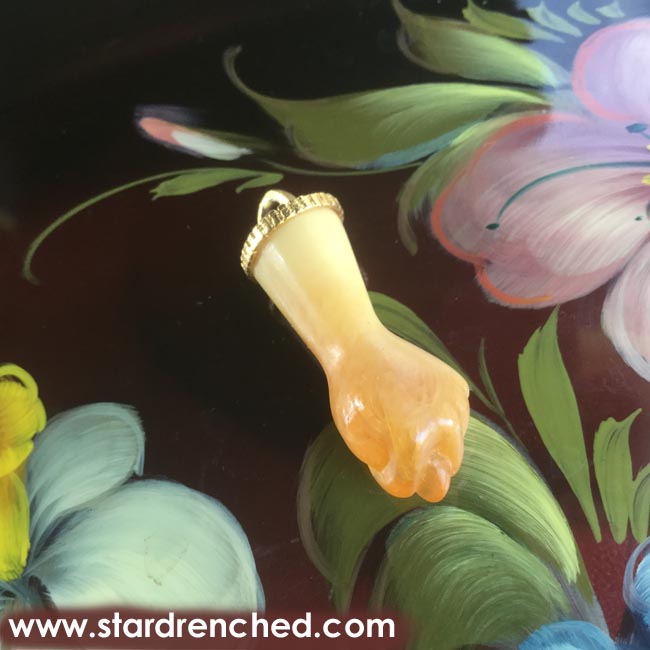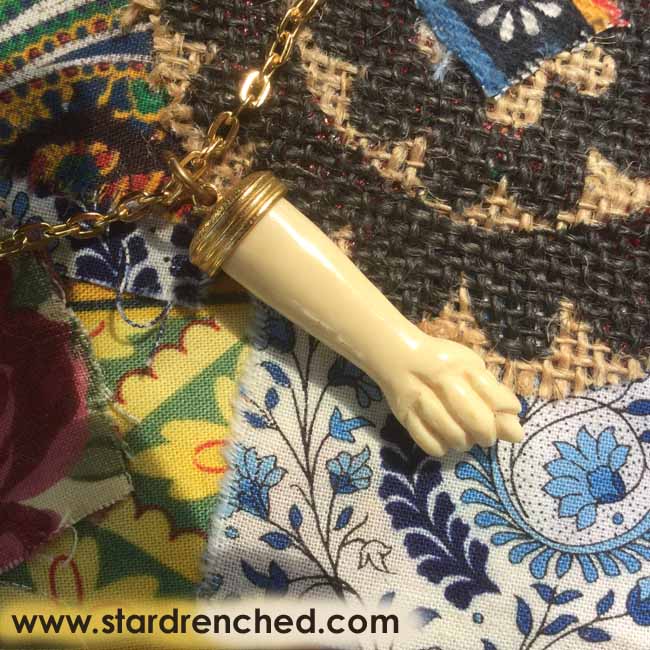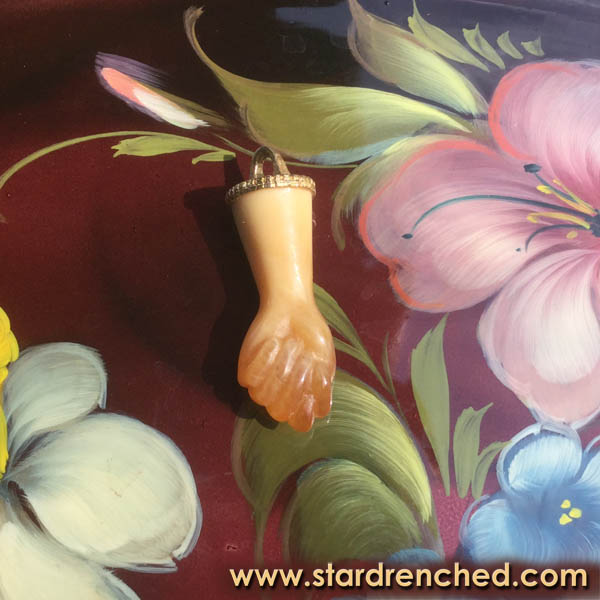The Figa
Reclaiming Women’s Power and an Italian Amulet
A figa is an amulet in the shape of a closed hand. Often, the tip of the thumb peeks out between the middle and index finger. The figa represents a woman’s genitals and is a charm for protection and good luck. It is also a talisman for fertility.
Even as a youth, I was drawn to the figa, not only as a talisman but as an archetype. It held tantalizing mysteries, and its antiquity and exotic roots were a delicious contrast to the American 50s bland norm.
I acquired a new figa recently, and shot the above photo, so you could see it. Isn’t it beautiful? I absolutely love it!
I purchased my new amulet here; the shop has more, each one different: https://www.etsy.com/shop/ErikasCollectibles
I’d already had a figa for … hm, I don’t know how long. It could be 30 or 40 years, or far less. I don’t remember how I acquired it. I was raised in an Italian, shamanic family-tradition. Otherworldly sensibilities were so typically present in our home, a part of daily life. A figa could slip into my life seamlessly back then, the entry not as noteworthy as it could be for people who aren’t constantly surrounded by that sort of thing.
Yet, despite my familiarity with Italian folk culture and my intense draw to this charm, I rarely saw one that I thought beautiful. I was never fond of my old figa, had wanted a new one forever, but couldn’t find one that pleased me till now.
My finally liking one is significant to me as a woman. Read on to learn why.
Seeing my new figa, which is very feminine, sweet, and elegant, I realized by comparison why I’d rarely liked a figa in the past. For one thing, they’re usually quite macho. An object that is supposed to embody female sexuality should … embody female sexuality.
Plus, figa figures are often crude. The crudeness repelled me, though on a subconscious level until I saw my new sweet, elegant figa. The crudeness—again, I experienced this subconsciously—was like being slapped in the face, shamed for being female.
Instead, I adore my new charm. Its sweet, feminine elegance is powerful magic and significant healing.
I was blown away by the shop’s photograph of this piece. And I did my best when I took the photos for this post, but it’s even better to see it in person; its exquisite artistry almost took my breath away. The careful sculpting of an elegant, feminine hand, enhanced by the marbling of its resin, makes it a true treasure.
It triggered a train of thought. The charm must not only be an Italian folk symbol for female sexuality per se, but also imply lot more. The figa must have originally symbolized everything—everything—a woman can be if she is unbound; her full being realized and expressed. The amulet must have once represented this totalness of being and potency in all parts of life. Otherwise, I do not believe the charm would have become so incredibly popular. It is worn not only by Pagans but by many Italians, including Christians.
 Be clear, when I write, “Everything a woman can be,” I’m implying everything a human can be. I am positioning a woman’s sexuality as potency, the same way a man’s sexuality is often viewed as potency in his business and all other parts of his life.
Be clear, when I write, “Everything a woman can be,” I’m implying everything a human can be. I am positioning a woman’s sexuality as potency, the same way a man’s sexuality is often viewed as potency in his business and all other parts of his life.
I love folk art, folk magic, and the place where the two intersect. I also believe one might better understand a piece of folk art if one knows the cultural norms prevalent when the piece was made. That includes pop culture. Enter Kenneth Lane. The figa I bought is a vintage Kenneth Lane.
What was occurring around jewelry designer Kenneth Lane when he had the urge to create a figa that would be neither vulgar nor shaming? What in the political climate impelled him? Or did something solely personal to him serve as motivation? (The political always impacts us personally, but you know what I mean.) Whatever it was, we owe him a debt.
I mean, “figa” is Italian for the demeaning term “pussy.” The styling of most figa figures reinforces that nastiness. I do not object to a figa shaped roughly in a spirit of exuberance, or if a limited skill set did not allow finely honed lines. What I oppose is the consistent vulgar representation and the overall gestalt it feeds, a deeply hurtful cultural norm.
By the way, I see nothing wrong with a masculine figa per se, but there’s something wrong with a feminine symbol generally being masculine.
In any case, Kenneth’s jewelry was popular with Hollywood stars. Although many Pagans wear a figa, the pendant is also popular with non-Pagans. So people can knock pop-culture all they want, but I bet Kenneth’s pendants made women of all kinds proud of being women.
Kenneth’s styling was powerful. It wasn’t until I saw it that I could understand by contrast how demeaning most figas are and reclaim another part of my power. His rendering of the figa was able to heal me from a cultural norm so deeply ingrained and horrible that it still hurt my soul despite my fierce pride in my female nature and witchy wildness. I have a new piece of my magic as a woman and a new piece of my womanly pride.
What had been a sacred image in ancient Rome lowered in value until it became used as a rude gesture. A symbol that once must have honored women came to denigrate them. I believe Kenneth helped change that. I hope my thoughts here help a bit, too.
The profound power that exists in every human is diminished when we reduce anyone’s power through shaming depictions.
But when we shine a light on the wonderfulness of those around us, our own powers shine.
… Now the only problem I have is how to stop myself from buying all the figas in the shop. There’s a gorgeous variety, each piece quite different. I’ve already bought a second one. Here it is on my altar:
 I will treasure these figas always. Here’s where to acquire an outstanding charm: https://www.etsy.com/shop/ErikasCollectibles
I will treasure these figas always. Here’s where to acquire an outstanding charm: https://www.etsy.com/shop/ErikasCollectibles


Pingback: The Figa: Healing the Wounded Anima | Outlaw Bunny
Pingback: Our Bodies Are Sacred | Outlaw Bunny